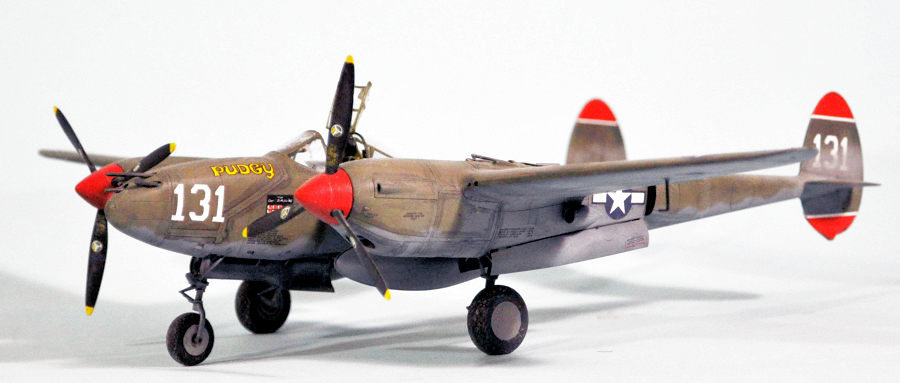
Tamiya 1/48 P-38H Lightning
| KIT #: | 25199 |
| PRICE: | $16.98 |
| DECALS: | One option |
| REVIEWER: | Tom Cleaver |
| NOTES: | Aeromaster 48-058 “Early Lightnings” used |

| HISTORY |
The summer of 1943 finally saw the Fifth Air Force begin to receive the desperately-needed reinforcement and expansion that General Kenney had argued for since his arrival in Australia. General Kenney was thrilled to discover that the Fifth’s new reputation after the Battle of the Bismarck Sea meant his trip to Washington had paid off with a shipment of 100 of the 350 P-38Hs that had been produced as “stopgaps” when production of the P-38J was slowed by lack of engines, to bring the three existing P-38-equipped squadrons, the 80th squadron of the 8th Fighter Group, the 39th squadron of the 35th Group, and the 9th squadron of the 49th Group back to full strength, and to achieve his goal of one group fully-equipped with the Lightning, which the general considered the best fighter available for conditions in New Guinea.
Kenney called the 475th Fighter Group into existence on May 14, 1943, as the third fighter group to be completely created overseas after the AVG became the 23rd in July 1942 and the RAF Eagle Squadrons had become the 4th Fighter Group in England in September 1942. The P-38H had a reputation for engine cooling problems, but Kenney was happy to get any P-38s he could; in the meantime, he kept his plans for a completely new fighter group secret since other P-38-equipped fighter groups already in combat in North Africa and the Mediterranean were screaming for replacement aircraft and the leaders of the Eighth Air Force were begging for P-38s to provide long-range escort in England. Originally, the unit – composed of the 431st, 432nd, and 433rd Squadrons — was to be activated at Charters Towers in Queensland, but instead was established at Amberley Field outside Brisbane, located close to the supply depots.
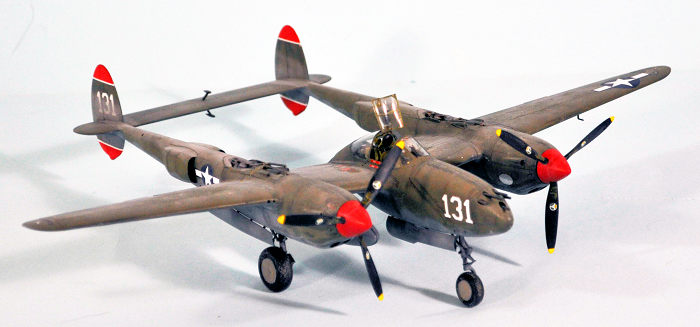 Kenney had to find pilots and ground crews for the group within Fifth
Fighter Command, and put out word to the commanders of the other fighter groups
when he ordered them to send six pilots from each of their squadrons to the new
group that he wanted no “deadheads” and would hold each group commander
personally responsible if the order was not followed to the letter. Thus, the
475th was well on its way to becoming the premier fighter group of the Fifth Air
Force from the beginning.
Kenney had to find pilots and ground crews for the group within Fifth
Fighter Command, and put out word to the commanders of the other fighter groups
when he ordered them to send six pilots from each of their squadrons to the new
group that he wanted no “deadheads” and would hold each group commander
personally responsible if the order was not followed to the letter. Thus, the
475th was well on its way to becoming the premier fighter group of the Fifth Air
Force from the beginning.
Among the other newcomers who reported to the group was 1st Lieutenant Thomas Buchanan “Tommy” McGuire, Jr., who was transferred from the 49th Fighter Group’s 9th squadron on July 20, a bit less than two weeks before his 23rd birthday. Five feet seven inches tall, he sported a big black mustache in an attempt to appear older. In McGuire’s case, the 49ers were both following General Kenney’s directive to send excellent pilots, and ridding themselves of a pilot they considered a misfit. By the time he came to the 475th, McGuire had acquired a reputation for being prickly and difficult to know, a man whose reputation was based on his skill in the cockpit of a P-38, not for his interpersonal skills. Many years later, one of his 431st squadron mates would remember him thus: “Tommy McGuire was a complete failure, socially. But he knew more about the P-38 and how to get the most out of it, of anyone. He could talk for hours about that airplane in great detail, to the point of driving everyone else nuts.”
Once in the 431st, McGuire got a reputation in the squadron as a “brown-noser,” when his enthusiasm for the P-38 resulted in his appointment as squadron maintenance officer. This attitude quickly changed when aircraft availability moved up from 50 percent to over 80 percent with the ground crews’ morale rising from the inspirational leadership of a young officer who didn’t pay attention to military propriety and wasn’t afraid to get his fingernails dirty working on the airplanes with them.
The 475th group flew their first mission to Wewak on August 17, flying
with the B-25s of the 38th group and completely surprising the enemy, who put up
no aerial opposition. The next day saw a second mission to escort B-25s of the
38th group on a strafing mission to hit Dagua airdrome outside Wewak. Lieutenant
McGuire, who had missed engaging the enemy during the fight at Tsili Tsili was
among those assigned to the mission, flying a P-38H-5 he had named “Pudgy.” When
seven Ki.43 Oscars from the 24th Sentai, nine
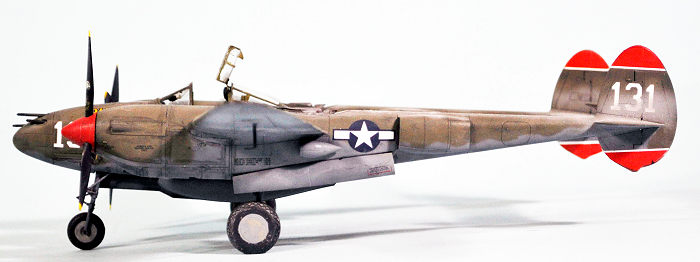 Oscars of the 59th Sentai, five
Ki.61 Tony fighters of the 68th Sentai and two Ki. 45 Nick fighters from the
13th Sentai rose to contest the American attackers this time, McGuire
demonstrated his flying and gunnery skills when he attacked five Ki.43s he
mistakenly identified as Zeros, shooting down four. Back at base, his wingman
2nd Lieutenant Fran Lent, also put in a claim for the fourth victory. There were
no shared kills in the 475th, a coin-toss would determine who received full
credit. McGuire lost, and was given credit for three, which was quite a way to
lose one’s “virginity.” He was in the group’s forefront now and would never lose
that status.
Oscars of the 59th Sentai, five
Ki.61 Tony fighters of the 68th Sentai and two Ki. 45 Nick fighters from the
13th Sentai rose to contest the American attackers this time, McGuire
demonstrated his flying and gunnery skills when he attacked five Ki.43s he
mistakenly identified as Zeros, shooting down four. Back at base, his wingman
2nd Lieutenant Fran Lent, also put in a claim for the fourth victory. There were
no shared kills in the 475th, a coin-toss would determine who received full
credit. McGuire lost, and was given credit for three, which was quite a way to
lose one’s “virginity.” He was in the group’s forefront now and would never lose
that status.
On August 21, leading the 431st’s Blue Flight, he shot down two more Ki.43s and a twin engine Ki. 45, to become the first pilot to be credited as an ace completely within the group. On August 29, on the group’s 14th mission to Wewak, this time escorting B-24 bombers in a high-altitude attack, McGuire shot down a Ki. 43 and a Ki. 61 to bring his score to seven, tying him with 1st Lieutenant David Allen for leading ace of the group.
As he turned away from his second victory, McGuire came under fire from another enemy fighter and his left engine caught fire. He coolly shut down the engine and let the propeller windmill while he dropped to 9,000 feet, which put out the fire. Two enemy fighters followed him and he finally shook them by diving into clouds at 4,000 feet. With the engine out, he didn’t feel able to make it back to Moresby and so landed at the forward airstrip at Marilinan, where he successfully landed single-engine. Future mayor of Los Angeles 1st Lieutenant Sam Yorty, at the time intelligence officer for the 41st Fighter Squadron of the 35th Fighter Group, took down McGuire’s account of his fight with enemy pilots he termed “both experienced and eager.” Yorty wrote a final remark in the report to describe McGuire: “this pilot remained calm in spite of the fire in his engine, and thereby successfully brought himself and his airplane safely to this base.” McGuire caught a ride on a C-47 the next morning and returned to his squadron, where he was given another P-38H, which he also named “Pudgy;” this time he had the name painted on the nose, above a scoreboard of Japanese flags. On September 28, he christened the second “Pudgy” by shooting down two more Ki. 43s over Wewak, to bring his score to nine and put him at the top of the group’s list of aces.
| THE KIT |
According to the tale my mother always told, I have apparently had a love affair with the P-38 since a very young age, ever since at age ten and a half months when I was in a park with her as a P-38 flew overhead, which I pointed at and screamed “O-pane! O-pane!” – my first intelligible word. I have liked the P-38 ever since.
Tamiya wowed the modeling world a year ago when they released their
F-38F/G kit. The kit is a marvel of production design, since it deals
successfully with the two biggest bugaboos modelers have had with P-38s since
the first kits came out: getting everything aligned, and insuring the model is a
nose-sitter. The kit has a skillful design with an internal structure that
insures the two booms fit similarly, and that the horizontal stabilizer is,
indeed, horizontal. Additionally, there is a cleve r design to place kit-supplied
weights in the nose of the central nacelle and the engine compartments of the
booms. There is never going to be any doubt that the model will sit properly.
r design to place kit-supplied
weights in the nose of the central nacelle and the engine compartments of the
booms. There is never going to be any doubt that the model will sit properly.
When the kit first came out, I saw a YouTube video in which a modeler completely assembled the kit (other than the cockpit parts) without use of glue and had it sitting on its gear. That’s how close the parts fit. In fact, the design of this kit is such that anyone, from someone new to the hobby to someone with more hours invested than even I have, who takes their time and follows the instructions (they’re not “somebody’s opinion”), will have what each will call “the best model in my collection!” The design of this kit is so modeler-friendly that one would have to develop a detailed plan in advance in order to mess things up. Parts fit in such a way that they ONLY fit where they’re supposed to be, the way they’re supposed to.
This P-38H kit, which is a limited one-time-only release, adds a sprue – Sprue J – of specific parts for a P-38H, including the air intakes for the turbochargers, the nose gear leg, the main gear legs, the interior to the nosewheel door and the door retraction mechanism, the machine gun barrels (a different pattern than the earlier versions) and the “acorn shaped” oil coolers that mount on the booms. Sprue H, the clear sprue, has the correct one-piece rear clear part for the P-38H, as opposed to the multiple parts of the P-38F/G.
Tamiya gets everything right except the painting instructions for the landing gear. The kit instructions call for the interior of the wheel wells, the interior of the gear doors, and the gear legs to be painted aluminum. While this is correct for the P-38F/G, it is incorrect for the P-38H. All of the P-38Hs and the P-38J to the P-38J-15 sub-type, had the landing gear, gear wells and gear door interiors painted the aircraft underside camouflage color, Neutral Grey. With the P-38J-15 and subsequent, and the P-38L, which were all delivered in unpainted aluminum, the gear was left unpainted. This is admittedly “obscure knowledge,” so Tamiya shouldn’t be faulted for getting wrong what lots of other people and all other kit manufacturers, have also boo-booed.
| CONSTRUCTION |
 This kit is complex, but it is not complicated. It is the most
“modeler-friendly” kit design I have encountered in any model I have ever built.
Regarding the instructions, they are not “someone’s opinion,” and you really
should follow them (other than where I deviated for convenience). As with any
CAD-designed kit, you must be absolutely certain to trim away every tiniest bit
of sprue nib residue on the parts, and it’s a good idea not to paint the
surfaces of the parts to be glued together. The parts fit is that precise and
tight.
This kit is complex, but it is not complicated. It is the most
“modeler-friendly” kit design I have encountered in any model I have ever built.
Regarding the instructions, they are not “someone’s opinion,” and you really
should follow them (other than where I deviated for convenience). As with any
CAD-designed kit, you must be absolutely certain to trim away every tiniest bit
of sprue nib residue on the parts, and it’s a good idea not to paint the
surfaces of the parts to be glued together. The parts fit is that precise and
tight.
My only deviation from the assembly sequence was to perform the assembly of the entire cockpit in one complete process, combining the first part of the assembly at the outset with the second part of assembly shown at close to the end, because I wanted to get all those parts into the cockpit and under the protection of the canopy early on, in the expectation that otherwise something irreplaceable might get knocked off. I also cut away the sun shade, because it was not used that frequently; as Steve Hinton, the highest-time P-38 pilot in the world, pointed out to me, it’s a lot easier to glance at the instruments if you don’t have to lean over to look under the shade. Doing this also opens up more of the nicely-detailed cockpit to be seen once the model is finished. The fact it’s provided as a separate part makes this bit of surgery very easy. I sued Eduard photo-etch seatbelts here, the one nod to aftermarket items other than the decal sheet I used.
The attachment of the armor glass and the gunsight to the forward windscreen part is a little tricky, and the slightest slip will have you putting glue into the clear area of the windscreen, which happened to me here. The solution is to attach these parts with Micro Krystal Kleer and let them set up. If you miss perfect alignment there, the glue will dry clear and no one will be any the wiser.
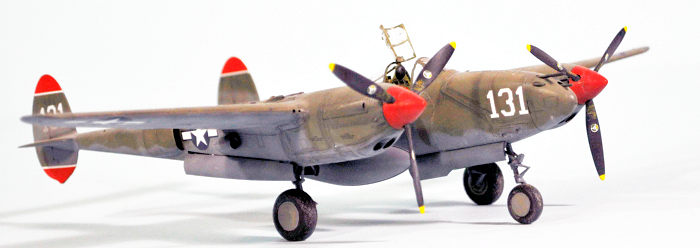 Some researchers have said that early P-38 cockpits were painted “Olive
Drab.” If so, it almost certainly would have been the “RAF Dark Green” color
that is analogous to green-base OD-41. I opted here to go with an Interior Green
mix, with semi-gloss black for the various “black boxes.”
Some researchers have said that early P-38 cockpits were painted “Olive
Drab.” If so, it almost certainly would have been the “RAF Dark Green” color
that is analogous to green-base OD-41. I opted here to go with an Interior Green
mix, with semi-gloss black for the various “black boxes.”
The provision of steel balls for weights is really ingenious, and the manner in which the cockpit tub is attached to the upper part of the central nacelle is guaranteed to get everything located precisely where it should be. The provision of the wing spar that also has the attachment for the weight in the nose insures that the alignment of this sub-assembly will be completely problem-free.
The booms are similarly precise in design. Unlike the Hasegawa kit, where the different radiator intakes do not attach on a panel line, and thus have to be puttied and sanded smooth with the panel lines rescribed, every separate part on these booms – which are separate because they will be replaced in different subsequent releases – are attached on a panel line.
The wheel wells are far more detailed even than the 1/32 Trumpeter kit I built, and far moreso than the Hasegawa kits, without being complicated to assemble. The method of attaching the gear doors is another ingenious little detail, in which it is impossible to get the wrong door on the wrong side, with a strong attachment that completely solves the problem of the most annoying part of assembling a Hasegawa kit.
The booms attach to the wing/center nacelle sub assembly by “clicking” (listen for it) into place. The piece de resistance is the one-piece horizontal stabilizer that slides into position in such a way that it guarantees alignment between the two booms (something you have to fiddle with when assembling a Hasegawa P-38). I assembled the entire model other than the wheels and the turbochargers.
| COLORS & MARKINGS |
Since I was modeling Tommy McGuire’s second (named) P-38H “Pudgy,” I considered what the airplane likely looked like (there are no full-airplane photos) at a point in time. I chose to do the airplane as it would have likely appeared at the end of September, 1943, after he shot down victories 8 and 9 on September 28.
The airplane was a replacement, which meant it was one of the original
100, and remained behind at Amberly. Most likely, it sat there in the winter sun
of Australia, with the upper surfaces fading, while the lower surfaces remained
their original shade. It wouldn’t have had a lot of use, so there wouldn’t have
been a lot of “wear” from people walking on it, “dings” from maintenace people
pulling panels, and from
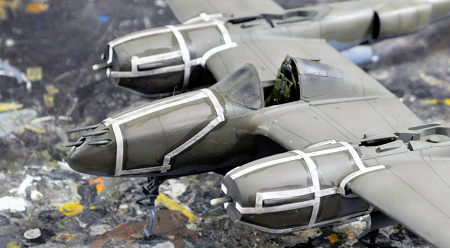 general operation. In other words, for the Southwest
Pacific, “Pudgy” was at this time a pretty clean P-38, other than for the tape
residue over the nose compartment and engine compartments that had been sealed
for overseas shipment.
general operation. In other words, for the Southwest
Pacific, “Pudgy” was at this time a pretty clean P-38, other than for the tape
residue over the nose compartment and engine compartments that had been sealed
for overseas shipment.
Thus, I did two different kinds of pre-shading. On the lower surfaces, I did the traditional flat black along panel lines, while the upper surface was first painted overall black, then “marbled” with white.
I painted the lower surfaces with Tamiya XF-53 “Neutral Grey,” thinned 50-50 to allow the preshading to show through a bit as color was deepened with repeated passes.
The upper surfaces were first painted with my mixture of brown-base OD-41 (which started being used in late spring 1943). This is a mixture of Tamiya “Khaki Drab,” “Olive Drab” and “Flat Earth,” about 60% Khaki Drab, 25% Olive Drab and 15% Flat Earth. This was thinned 50-50 and applied over the upper surfaces. I then mixed in a few brushfulls of Tamiya XF-19 “Sky Grey” and after thinning it to about 60 (thinner) 40 (paint) I went over the whole upper sufaces, repeating in various areas to get an inconsistent finish, thinking about the areas most exposed to strong sunlight. I then applied a little more Sky Grey and went over the wings and upper booms and horizontal stab to lighten a bit more. A final coat saw a brushful of Tamiya “Desert Yellow” and thinned it down to around 65-35 and misted it on over the rest.
After all that was dry, I used some Tamiya “Masking Tape for curves” and “sealed” the nose and engine compartments. I then brush painted thinned Tamiya “Smoke” along their edges, to replicate the sealer that was liberally brushed over the tape once the plane had been sealed, as a departed friend who worked for Lockheed during the war told me they did to prepare the planes for overseas shipment. When I pulled off the tape, it looked close to what photos showed the airplanes looking like after they were unsealed. I then applied a coat of Future to prepare for decaling.
 I used the Aeromaster “Early Lightnings” 48-058 that I found at the
“estate sale” at the Local Hobby Shop, which has “Pudgy”.It also has the tail
tip markings, which makes things easy. I modified the scoreboard, which has the
full 14.5 victories he had when he moved on to “Pudgy III” in the spring of
1944, back to the 9 as of the end of September 1943.
I used the Aeromaster “Early Lightnings” 48-058 that I found at the
“estate sale” at the Local Hobby Shop, which has “Pudgy”.It also has the tail
tip markings, which makes things easy. I modified the scoreboard, which has the
full 14.5 victories he had when he moved on to “Pudgy III” in the spring of
1944, back to the 9 as of the end of September 1943.
I gave the model several coats of clear flat varnish, then made some very slight “dings” near the cockpit. I trimmed the side panels a bit more than Tamiya had them, since I have noticed with the P-38s seen out at Chino that those side panels are wound down to insure no damage climbing in and out of the cockpit. I attached the “lid” in the open position. I attached the turbochargers, then applied the turbo exhaust staining with Tamiya “Sky Grey” thinned 50-50. I drybrushed the wheels with Tamiya “Buff” enough to see the tread pattern.
| CONCLUSIONS |
Tamiya has definitely “aced”the P-38 in terms of kit design and buildability. However, remember that “buildability” and “accuracy” are two different words. Do your research about how to paint the model. Recommended for any modeler willing to follow the instructions. If you do, the result is guaranteed that you will have a great model on the shelf when done.
Tom Cleaver
8 October 2020
Copyright ModelingMadness.com
Review kit courtesy of a timely royalty payment.
If you would like your product reviewed fairly and fairly quickly, please contact the editor or see other details in the Note to Contributors.